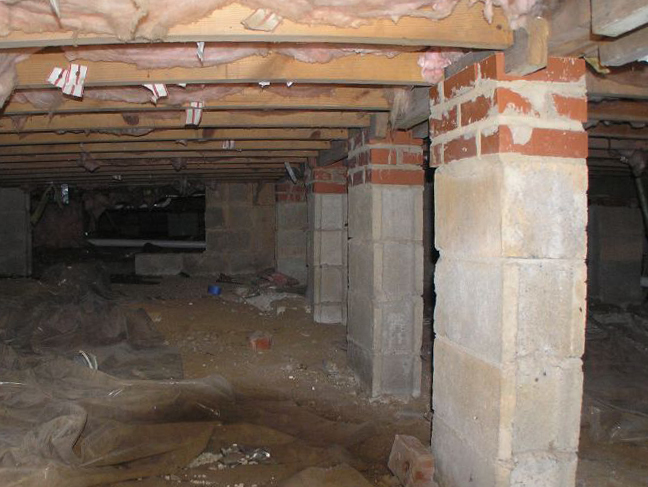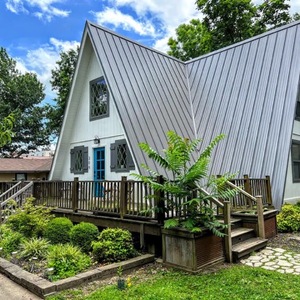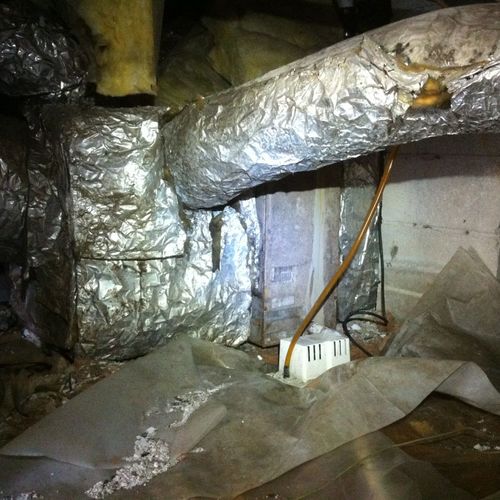
Image Credit: Shister
Crawlspaces are like the Loch Ness monster: talked about, rarely seen, and potentially a bit scary.
The crawlspace is that empty, barely accessible pit under the house filled with swampy water, cobwebs and spiders the size of dinner plates. (That link was the Google result for “spiders the size of dinner plates.” Enjoy). At least that’s what we imagine.
Out of sight, out of my mind
The reality is hardly any prettier (but hopefully no Loch Ness or Shelobs). Persistent problems live in crawlspaces — ones that stick around because the homeowner never sees them. My all-time most ridiculous find was a running hair dryer, warming water pipes that had frozen. The homeowner’s daughter had done it without telling anyone and forgotten about it in the intervening two months. The electric bills were … impressive.
There are other widespread problems that remain similarly out of mind. Moisture is a major one. Whether it’s running water, standing water, or moisture evaporating from a sandy crawlspace floor, any damage or problems won’t be seen.
If a full basement leaks or floods, sumps and mops will be deployed immediately. In a crawlspace, however, unseen moisture can damage wood, concrete, and make its way into the house.
The connected crawlspace
That shouldn’t be a problem, right? I mean your crawlspace is entirely separate from your house … right?
Actually, no. When conducting a blower door test, we check the house in several configurations, one of which is with the basement or crawlspace access door open.
When a blower door test is performed, sometimes the pressure reading doesn’t change, whether the crawlspace access is open or closed. Big deal, right? Actually, it means that the holes (and air flow) between the crawlspace and first floor are so large and so profound that it doesn’t matter if the door is open or not.
All that grimy water, dust, and pest waste can float up into your house and get breathed in. Ugh! What could be worse? How about locating ducts in that crawlspace?
Mechanical monsters
Yes, thank goodness there’s no giant mechanical system moving tons of air into the house. Oh, wait — there is: your ducted HVAC system. Often your HVAC system ducting is run through the crawlspace, which is just an awesome way to move all the dust, moisture, rodent poop, and chemicals into the rest of your house.
A well taped and mastic-sealed duct shouldn’t be an issue. In theory. The reality is there are usually loads of poorly installed and unsealed ducts running through the nasty crawlspace.
This can act as a “crap in the crawlspace” ventilation system. If the ducts handle cold, conditioned air in a humid crawlspace, then condensation is in your future. If the ducts have a foil sleeve, the condensation may accumulate within the sleeve. There is a scary potential to create a breeding ground of awfulness.
Venting problems are not just for attics
Another common problem is the vented crawlspace. Venting can be a crapshoot in attics, and a vented crawlspace can be a problem in humid climates. The idea behind ventilation is improving the interior air and conditions.
What if the exterior air is worse than the interior air? Then a hole into the crawlspace will let in problems. This can be adorably compounded when some right-thinking owner puts a dehumidifier down there. It’s a noble thought to try dehumidify the whole planet.
There is one last issue to discuss: any efforts to insulate the ceiling joists with fiberglass batts. (I detailed the thermodynamics of this approach in an article called “Should I Insulate My Basement Ceiling?”) Practically, fiberglass batts are not great. Between gravity, moisture, and cold, there can be problems. It’s a rare install where three-quarters of the batts aren’t hanging down or fallen off entirely.
Crawlspaces can be a pain in the butt. Unlike basements, where the homeowners may see and fix any problems, crawlspace problems can fester for ages. And problems that occur in the crawlspace affect the whole house. Take care of your crawlspace and you’ll take care of the whole house.
Erik North, the owner of Free Energy Maine, is an energy auditor and home performance specialist in Westbrook, Maine. He is also the author of the Energy Auditing Blog.
Weekly Newsletter
Get building science and energy efficiency advice, plus special offers, in your inbox.















10 Comments
Enclosing duct work in crawl space
Erik,
We are currently building a relatively small house and the downstairs ducts will have to be in the crawlspace (well, actually under the house which is on piers). I haven't seen good information on how to enclose the ducts. At the beach where houses are often on piers, the ducts are enclosed, but ventilated.
Can you give me some advice on effective methods of closing in the ducts such as insulated plywood box, no flex duct, only mastic-sealed rigid ducts, or a foam box sealed around the duct work?
Thank you.
yes, and a question
Erik: yes, yes, yes and yes to all of the above -- we ended up encapsulating but leaving it vented -- a compromise in honor of the radon readings, but OC foam sealed the cs from the first floor. I hope.
But listen -- my wife needs a new hair dryer, she says. And she wants to know the name, model # and any other information that will let her source a hair dryer that won't burn out. She's very impressed.
That is so funny
Joe W,
It took me about 5 minutes to get what you were asking about the hair drying. Really funny.
I'm having a hard time
I'm having a hard time understanding the point of this article in a forum dedicated to improving poor building practices, not just grumbling about them. Yes, Erik's critique of the traditional vented crawl space is valid. What I don't get is why there is no mention of the fairly straightforward techniques that have been well documented in GBA and elsewhere for remedying this common but in most cases easily fixable state of affairs. Just adding a single sentence with a page link like this one would have been enough to give the article some sense of purpose:
https://www.greenbuildingadvisor.com/blogs/dept/musings/building-unvented-crawl-space
Encapsulated but vented?
Joe W, I'm not sure what that means.
Response to James Morgan
James,
Thanks for your comments. I'm sorry to hear that Erik North's article didn't speak to you. There are many voices here at GBA, and different readers favor different writing styles. We have a lot of voices to choose from.
Evidently, you don't get "the point." Here are a few:
If your house has a crawl space, it's a good idea to inspect it regularly.
If you haven't built your house yet, you might want to consider some of the potential disadvantages of conventionally built crawl spaces.
If you have ducts in your crawl space, you might want to seal the duct seams.
And by the way -- the article you linked to is the first one on the list in the "Related Articles" box, so alert readers already had a link to it.
Response to Martin
Sorry, Martin, but I stand by my comments. It's hard to imagine a GBA article on other common building assembly options, vented roofs say, or cellulose insulation, which only discusses problems and bad examples and leaves readers with the impression that the best thing to do is to avoid them altogether: an impression, by the way, which a generic sidebar link is hardly enough to counter. I think GBA is displaying its northeastern regional focus in what seems to be a general editorial bias against crawl spaces, even apparent in the otherwise excellent article of yours I linked to:
"Slabs have several virtues: they are inexpensive and they keep all of a home’s living area above grade, away from dampness and mold. Basements also have their virtues: they keep plumbing pipes from freezing, provide a good place to install a furnace and run ductwork, and provide a useful area for storage. Crawl spaces cost almost as much as a basement, with none of a basement’s advantages."
Ask a builder hereabouts to build a full basement for "almost" the cost of a crawl space and they'll laugh in your face. The upcharge for a full-height unfinished basement over a standard vented crawlspace is typically $30/40 per square foot, even if the terrain is suitable (not often the case), while the upcharge for a high performance encapsulation, which would obviate all the disadvantages Erik lists, is less than a tenth of that. In fact encapsulation has become so much the standard here in the last few years that it's hard to see it as an upgrade any more. Meanwhile, our gently rolling terrain frequently means that slabs are far from cheap: the cost advantages of a slab foundation are pretty much gone when you have to pour in several feet of clean stone fill and engineer your stem walls to prevent them bursting.
Your article continues:
"Crawl spaces are more of a puzzle, and it’s hard to come up with a reason to like them."
I'm guessing many readers would have stopped right there. I'll give you full credit for continuing your article with a thorough description of how to do crawl spaces right, but really. I suppose you mean, any reason other than the clean, conditioned mechanical and services distribution space underlying the entire footprint of the house, permitting easy access for plumbing, electrical and data-conduit upgrades and modifications at any point in the building's long life. I'm sure that not every US region is ideally suited to crawl space construction, but for the many that are, how green is that?
James,I think the purpose of
James,
I think the purpose of the article is fairly clear: "Problems with Crawlspaces". Maybe a good follow up would be 'Solutions for Crawlspace' (granted it's been done elsewhere).
And I will cop to a bias but it's no more pronounced a regional bias than say Allison (a Georgia resident) and his numerous posts on ductwork. We all have a regional bias...the one we live in.
You seem to have the takeaway that my position is that crawlspaces should always be avoided. My feeling is that crawlspaces have all of the mechanical and structural context of a basement without the ease of access or connection.
A slab just sits under your house with no mechanicals or storage. A basement has a stairway to easily walk down. Maybe your washer/dryer is down there, meaning continual traffic. Any problems will have eyeballs on them. A crawlspace? Best case there is a walk out on the exterior, worst case you'll need to cut an access through the flooring. Too too often, conversations with clients have included some variation of "I haven't been down there in 10 years."
Response to Erik.
"You seem to have the takeaway that my position is that crawlspaces should always be avoided. My feeling is that crawlspaces have all of the mechanical and structural context of a basement without the ease of access or connection."
I'm not sure what this means exactly. The implication seems to be that therefore they should indeed be avoided. Your comment simply confirms your antipathy to the form.
"Too too often, conversations with clients have included some variation of "I haven't been down there in 10 years.""
And too often I have had interactions with clients who have failed to notice that their gutters are falling off, their fascia boards are rotting and their rainwater leader pipes are discharging volumes of stormwater directly against their foundation walls. I could write an article saying that gutters, fascia, rainwater leader pipes and foundation walls suck, or I could point out the problems and suggest solutions for repair, improvement and maintenance. GBA has a superb track record for generally taking the latter approach. I live and practice in an area where the crawl space is (for a number of very compelling reasons) the standard foundation system, where many of these especially the older ones are problematic for many of the reasons you cite, and which we are regularly able to remedy with little fuss or expense. My clients can hardly take encouragement from an article which as much as says, sell your crappy home to another sucker and build a new one with one of 'our' preferred foundation solutions. Which, by the way, are seldom optimal for our terrain conditions. Crawl spaces work well here. We know how to do them right. A little more support to provide positive education on this issue to those of our clients and contractors who consult the best green home advisory forum in the country would be nice.
Response to James Morgan
James,
Thanks for sharing your perspective. I understand your point: in your area of the country, crawl space foundations are very common. It's important to do them right.
GBA agrees with you, which you seem to acknowledge. You've pointed out that there are "fairly straightforward techniques [for building a good crawl space] that have been well documented in GBA."
You have also written that "I could point out the problems and suggest solutions for repair, improvement and maintenance. GBA has a superb track record for generally taking [this] approach." Thanks for the kind words.
If any readers are still confused, here is a link to the GBA article that tells you how to build a good crawl space: Building an Unvented Crawl Space.
Erik North is an energy rater, home inspector, and home performance contractor. He writes technically accurate and humorous articles that are "reports from the field." Since I used to work as a home inspector, his stories ring true to me -- and make me smile. I've been in crawl spaces that are similar to the ones Erik describes. In fact, the vast majority of the crawl spaces that I have crawled through are closer to those described by Erik than the clean, dry, well-lit crawl spaces that we all hope to see some day, once the lion lays down with the lamb.
It's quite possible that those of use who have (at one time) inspected crawl spaces for a living find Erik's writing to be more humorous than architects do.
Fortunately, however (as I pointed out before), GBA has a wide number of articles on these topics. Anyone who wants to know how to build a good crawl space will find the information he or she needs here on the GBA site.
Log in or create an account to post a comment.
Sign up Log in